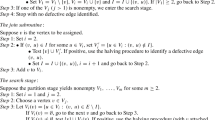Abstract
In this paper, we consider a network of switches in which some of the switches may malfunction. Our aim is to find out efficiently (a) if any of the switches in a network of switches are defective, and (b) if there are defective switches, to identify those switches. We find an optimal solution for the first problem and a heuristic solution to the second, and demonstrate the feasibility of our approach through computational experiments.





Similar content being viewed by others
References
Azwell, T., Blum, M.J., Hare, A., Joye, S., Kubendran, S., Laleian, A., Lane, G., Meffert, D.J., Overton, E.B., Thomas III, J., White, L.E.: The Macondo Blowout Environmental Report. Deepwater Horizon Study Group Environmental Report (2011)
Balding, D.J., Bruno, W.J., Knill, E., Torney, D.C.: A comparative survey of non-adaptive pooling designs. In: Speed T., Waterman, M.S. (eds.) Genetic mapping and DNA sequencing, pp. 133–154. The IMA Volumes in Mathematics and its Applications Book Series (IMA, vol. 81) Springer, New York (1996)
Babarczi, P., Tapolcai, J., Ho, P.-H.: Adjacent link failure localization with monitoring trails in all-optical mesh networks. IEEE/ACM Trans. Netw. 19, 907–920 (2011)
Cheraghchi, M., Karbasi, A., Mohajer, S., Saligrama, V.: Graph-constrained group testing. IEEE Trans. Inf. Theory 58, 248–262 (2010)
Du, D.-Z., Hwang, F.: Combinatorial Group Testing and Its Applications. World Scientific, Singapore (2000)
Dyachkov, A.G., Rykov, V.V.: A survey of superimposed code theory. Probl. Control. Inf. Theory 12, 229–242 (1983)
Hoshino, E.A.: The minimum cut cover problem. Electron. Notes Discret. Math. 37, 255–260 (2011)
Karbasi, A., Zadimoghaddam, M.: Sequential group testing with graph constraints. In: Proceedings of IEEE Information Theory Workshop (ITW), pp. 292–296 (2012)
Li, C.H.: A sequential method for screening experimental variables. J. Am. Stat. Assoc. 57, 455–477 (1962)
Loulou, R.: Minimal cut cover of a graph with an application to the testing of electronic boards. Oper. Res. Lett. 12, 301–305 (1992)
Motwani, R., Naor, J.: On exact and approximate cut covers of graphs. Technical report STAN-CS-TN-94-11, Stanford University, Department of Computer Science (1994)
Tapolcai, J., Wu, B., Ho, P.-H., Rónyai, L.: A novel approach for failure localization in all-optical mesh networks. IEEE/ACM Trans. Netw. 19, 275–285 (2010)
Acknowledgements
The author thanks Dr. Nilotpal Chakravarti for introducing him to the problem and for many fruitful discussions on the problem.
Author information
Authors and Affiliations
Corresponding author
Additional information
Publisher's Note
Springer Nature remains neutral with regard to jurisdictional claims in published maps and institutional affiliations.
Rights and permissions
About this article
Cite this article
Ghosh, D. Identifying defective network components through restricted group testing. OPSEARCH 56, 869–889 (2019). https://doi.org/10.1007/s12597-019-00382-3
Accepted:
Published:
Issue Date:
DOI: https://doi.org/10.1007/s12597-019-00382-3




